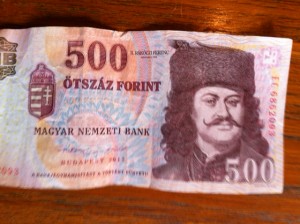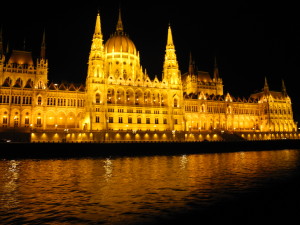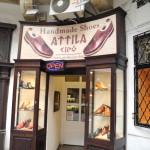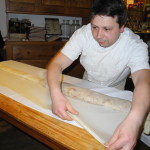On my recent trip to Central Europe with Insight Vacations, I enjoyed Prague immensely, discovered the delightful Medieval town of Cesky Krumlov (also in the Czech Republic), rekindled an old flame in Vienna, but fell totally in love with Budapest.
Maybe it’s because I’m a sucker for river cruises — the evening dinner cruise we took on the Danube was magical — or maybe it was the Hungarian Parliament building, lit up like a centenarian’s birthday cake at night and almost as beautiful inside by day, or maybe it was that lunch consisting solely of the best strudel I’ve ever eaten.
Probably some of all three, but there were also the endearing intangibles:
* Asking a couple of locals shortly after our arrival the name of the bridge in front of our hotel, then watching as they googled it on a smartphone and replied helpfully, “Suspension Bridge!”
* Later, strolling across that same “Suspension Bridge” — now knowing it was none other than Budapest’s famous 165-year-old Chain Bridge — connecting Buda and Pest (yes, the two sides of the city split by the Danube have separate names, kind of like what Istan and Bul would be like if it had separate names, but doesn’t) and wondering which side was actually Buda, and which Pest. So I composed a little rhyme to remember it: “One side’s east and one side’s west, and the one that’s west doesn’t rhyme with Pest.” Or you could just google it.

Hungary’s colorful 500 Forint note pictures a national hero from the early 1700s. Photo by Clark Norton
* Loving the description of “palinka,” a local brandy, as described by our Insight Vacations briefing sheet: “Deemed medicinal by the locals, they sometimes drink it before and after meals, as well as in the morning, afternoon and evening.” Other than that, they never touch the stuff.
* Listening to people speak Hungarian, which has nothing in common with any of the usual Indo-European languages. (One theory is that the Magyars, as they call themselves, first arrived from Mongolia in the 9th century, and they’ve kept their language more or less intact. But as our guide succinctly put it, “They don’t know where they’re from.”)
* Changing money into Hungary’s local currency, the forint, but not wanting to spend any of it because the bills are incredibly colorful and exotic-looking. The 500 forint note, for instance, pictures Rakoczi Ference, an early 18th century prince of Transylvania who led an uprising against the ruling Habsburg family.
* Wishing I had been around to collect a banknote for one quintillion pengo (1,000,000,000,000,000,000), the highest denomination bill ever issued. But as they say, a quintillion pengo just doesn’t go as far as it used to.
* Finding out that “Attila,” as in Attila the Hun(garian), is as common a name in Hungary as, say, “Bob” is in the U.S.
* Drinking some of the local coffee, described as “hot as hell, sweet as wine, so strong your spoon will stand up in it.” The locals drink five cups a day.
* Getting a kick out of the name “Goulash Communism,” which is what Hungary’s somewhat more relaxed version of the system was known under Soviet domination. Not that it was any laughing matter — a local museum dedicated to the era is called the Museum of Terror.
* Hearing that there’s virtually no time of year you can arrive in Budapest when there isn’t some kind of festival going on; when we were there, it was the Spring Festival. Expect music, brandy, sausages — any time of year.
* Digging into a sausage, even without the music or brandy.
* Regretting I didn’t have time to sample one of Budapest’s famous thermal baths, featuring up to 171 degree Fahrenheit waters, the hottest in Europe, and reputed to be replete with healing minerals that percolate up from hot springs below the city. (Do they heal scalded skin? I’ll find out next visit.)
* Watching as strudel makers at Reteshaz Strudel House stretched the dough so thin over an entire table that it was translucent — “so much so you can read a love letter through it,” we were assured, which sounds much better than “you can read your electric bill through it.”
* Learning that the symbol of Hungary, the crown given to St. Stephen (the country’s first ruler) by the Pope a thousand years ago and worn by the king only once, at his coronation — and now guarded by 60 rotating soldiers 24 hours a day in the Hungarian Parliament Building in Budapest — was, over the years, lost, stolen and kept in Ft. Knox in the U.S. for a period of time before being returned during the Carter Administration. (And thinking, “Huh? Did I hear that right?”)
*Flying out of an international airport named for a Hungarian pianist and composer — Franz Liszt — and wondering when the U.S. will name a major airport after, oh, Van Cliburn, Scott Joplin, or even Billy Joel or Jerry Lee Lewis? (At least New Orleans named its airport for Louis Armstrong.)
Thanks to tour director Neira Milkovic and other Insight Vacations guides for some of these items.
Next up: Taking in the sights of Budapest with Insight Vacations.















3 Responses to Budapest: My Kinda Two-Sided Town